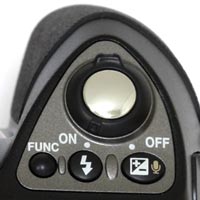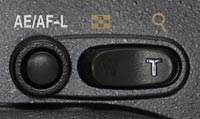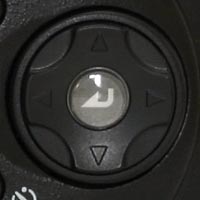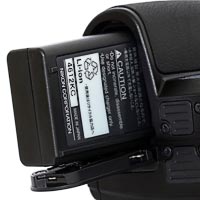Nikon Coolpix 8400
Review Date: May 23rd 2005
|
Ease of Use
The Nikon Coolpix 8400 looks and feels on first impressions like a small digital SLR, with a multitude of external switches and buttons (around 20 in total), chunky handgrip, external hotshoe (as well as the built-in pop-up flash) and a viewfinder that looks like a traditional optical viewfinder (but is actually electronic). If you have used a 35mm or digital SLR camera before, you will feel instantly at home with the Nikon Coolpix 8400. If your previous experience is limited to a compact digital or film camera, then be prepared to read the manual thoroughly, as this is a complicated piece of equipment that has a steep operational learning curve.
The Nikon Coolpix 8400 is on the whole very well built and designed and is made entirely of a solid magnesium alloy. It's one of those cameras that is not too heavy as to be cumbersome, but not too light as to feel flimsy. It has a reassuring weight and feel that instantly made me like the camera, with a substantial hand-grip coated in a textured rubber material to aid handling. Everything fitted my large hand size very well. The only gripes that I have with the handling of the camera are the positioning of the right strap eyelet, which is under your right hand and digs into it, and the zoom lever, which is positioned a little too centrally for my liking.
Unlike a DSLR, the Nikon Coolpix 8400 has an electronic viewfinder (EVF) instead of the more traditional optical version. On a lot of cameras the EVF is usually something of a weakpoint, but thankfully the Nikon Coolpix 8400 has a very good EVF, with no noticeable grain. It's equipped with dioptre control which allows you to fine-tune the display to your eyesight, and it display lots of information in a very clear and unobtrusive way. The only negative aspect is that it is quite dim, more so than the LCD screen on the rear of the camera.
| Exposure Mode Dial | Shutter Button / On/Off Button Function Button / Flash Button / Exposure Compensation Button |
 |
 |
The LCD screen is of the rotating variety. When its not being used it folds flat against the camera and is protected by a plastic back cover. When in use, you can rotate the screen 180° to the left and another 180° forwards, so that it actually faces you if you point the camera at yourself - great for self-portraits! You can then then rotate the screen 180° to the right onto the camera's rear so that it faces you like a conventional fixed LCD screen. Rotating LCD screens are a great way of getting a unique viewpoint on the world and add to the creative options that the Nikon Coolpix 8400 has to offer.
As stated above, the Nikon Coolpix 8400 has a large number of external buttons and switches on its body. If you have used a digital or film SLR camera before, then you will quickly find your way around the camera. There are around 20 external controls in total, with most of them clearly labeled using industry-standard symbols and terminology. Despite all those controls, the camera body still feels well-designed and not too cluttered. If you have never used a digital camera before, or you're upgrading from a more basic model, reading the comprehensive and easy-to-follow manual before you start is essential.
The menu system of the Nikon Coolpix 8400 is fine in most respects, but flawed in one. The font size, clarity and readability are all fine, with 7 options shown onscreen and 20 options to choose from in total. When you first access the menu system via the Menu button, however, the camera defaults to showing "My Menu", a sub-menu of 6 options that can be customized to include exactly what you want. The customisation aspect is fine, except that I found that 6 was far too limiting and I just ended up selecting the Show All Menus option most of the time. Very frustrating, as it meant an extra button press whenever I accessed the menu system.
| Auto-Exposure/Auto-Focus Lock Button / Zoom Lever | Arrow Pad / Select Button |
 |
 |
Something else that may initially confuse you is the way in which the Setup menu is accessed. It has its own dedicated setting on the shooting mode dial on the top of the camera, rather than being accessed via the Menu button as on most digital cameras. This didn't really bother me once I had got used to it, it's more something to be aware of if you have previously used a digicam from a different manufacturer.
Also found on the shooting mode dial are options for White Balance, ISO and Image Mode. It's great to see external controls dedicated to these commonly used options, making them a lot quicker to access than via the flawed menu system. It's not quite as convenient as a dedicated button for each option, however, as you have to rotate the shooting mode dial, make a selection via the LCD screen or EVF, then rotate the dial back round to the shooting mode that you are using.
The final comment that I have to make about the Nikon Coolpix 8400's control system is the way in which you playback your images. As with the White Balance, ISO and Image Mode options, Play is also accessed via the shooting mode dial. There is a Quick button on the rear of the camera which toggles between small and full-sized versions of the images that you have taken, but it doesn't give you the full range of playback options - you have to set the shooting mode dial to Play. Again a button would be quicker, and I'm not sure why Nikon's designers didn't just make the Quick button into the Play button.
| Battery Compartment | Memory Card Slot |
 |
 |
The start-up time of the Nikon Coolpix 8400, from turning the camera on to being ready to take a photo, is pretty quick at around 1 second, so you won't miss many shots whilst you're waiting for the camera to turn itself on. The lens is a little noisy when it extends and retracts, which may catch the (unwanted) attention of your subject. Shutter-lag isn't too noticeable at around 0.25 seconds. Focusing is very quick when using the Nikon Coolpix 8400 outdoors in good light and it's also fine indoors or in low-light situations at both wide-angle and telephoto zoom settings, thanks partly to the AF assist light. Storing a JPEG image at the best quality Extra setting causes a slight delay of around 0.5 second as the camera writes the file to the memory card (during which you can't take another photo). Be prepared to wait even longer if you are using the RAW or TIFF modes - the camera locks up for about 10 seconds in RAW mode and 20 seconds in TIFF after you press the shutter button, and you can't take another shot until it has finished recording the image.
The Nikon Coolpix 8400 has a whole host of continuous shooting modes, the quickest being Continuous H which allows you to take 2.3fps for up to 5 frames. Continuous L allows for more shots at a slower rate (1.2fps; up to 11 frames). Any image quality and size combination can be used in both of these modes. The camera does lock up again, however, after a sequence of shots is taken - at the best JPEG setting it takes around 7 seconds, and much longer for the RAW and TIFF formats. All in all the Nikon Coolpix 8400 is average in terms of operational speed but can be used equally well in both indoor and outdoor environments.
Once you have captured a photo, the Nikon Coolpix 8400 has an above average range of options for playing, reviewing and managing your images. You can scroll through the images that you have taken, view thumbnails, play a slideshow, and zoom in and out of the image up to a magnification of 10x. You can select which images you want to transfer onto your computer, delete an image, trim an image to a preset small size (with 3 different options), make a copy of an image, organise images into folders, protect images so that they cannot be deleted, and set various printing options. There is no histogram available during playback when using the Nikon Coolpix 8400, which is an important missing feature that a lot of other digital cameras in this class have, although there is one available when you are taking a photo.
Overall the Nikon Coolpix 8400 is a very well built, technically complex but relatively easy to use digital camera with a few things that spoil its otherwise great handling. The Coolpix 8400 isn't the fastest in its class in terms of operational speed (particularly writing files to the memory card), but it can be used equally effectively both indoors and out.
|
 PhotographyBLOG is a member of the DIWA organisation. Our test results for the Nikon Coolpix 8400 have been submitted to DIWA for comparison with test results for different samples of the same camera model supplied by other DIWA member sites.
PhotographyBLOG is a member of the DIWA organisation. Our test results for the Nikon Coolpix 8400 have been submitted to DIWA for comparison with test results for different samples of the same camera model supplied by other DIWA member sites.
